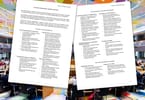(eTN) – The headline news in eTN about the takeover of Timbuktu by Islamists compels tourism stakeholders to think sincerely why such events are happening at the map of tourism?
With the rebels, including Islamist factions preaching Sharia of Islam, now in control of Timbuktu’s streets, tourists may not return soon to the spot near the Niger River that for centuries was a symbol of remoteness, bewitching voyagers with tales of wealth, wisdom, and life-giving water.
Some important questions that instantly come to mind after reading such news include:
– Why are terrorists attacking tourism destinations and tourists?
– Do terrorists attack tourist or tourism destinations to gaining maximum international media coverage?
– Do terrorists attack tourists to get the maximum impact of killing people of different nationalities in one attack?
– Do terrorists attack tourists because they are against tourism?
Why terrorists are targeting tourism destinations and tourists is a serious question that needs detailed research, or at the least, the attention of groups working to mitigate terrorism, but unfortunately, no serious work has been done so far in this field.
One of the most important tourism destinations in Pakistan was Swat Valley, which turned out to be the foremost target of terrorists, eventually gaining control of the valley for more than 2 years now. Terrorists are now reportedly moving to the rest of north of Pakistan, which is the most beautiful and peaceful area of this terrorism-ridden country, and the presence of Talibans have been claimed by local residents of Gilgit and Balitistan. Gilgit Baltistan is a gateway for extreme tourism, with international climbers and mountaineers coming from all over the world to conquer 5 out of 12 peaks above the 8,000-meter summits, including K-2, Nanaga Parbat.
On October 21, 1992, militants ambushed a tourist bus, killing a British woman and injuring two British men. The woman was the first foreigner to die in militant-related violence in Egypt. This news was a flashpoint of international electronic media for many days and in print media for many weeks. Egyptian militants considered this development a real success as it got international attention about their fight against the then Egyptian government, and it was an easy way to promote their struggle.
This event encouraged militants and terrorists to wage war against tourists in Egypt and to gain international attention. Then tourism destinations of Egypt faced a series of attacks followed by headlines and breaking news in the international media. A new tool had been invented by terrorists – kill tourists and get attention.
To understand the trend of terrorism against tourism, one can cite the following terrorist attacks on tourists or tourism destinations to look at the similarities of these events:
1 – Gunmen in Ethiopia’s arid north attacked a group of European tourists traveling in one of the world’s lowest and hottest regions, killing five, wounding two, and kidnapping two, an Ethiopian official said Wednesday, January 18, 2012.
2 – The 2005 Sharm el-Sheikh attacks were a series of terror attacks on
July 23, 2005, perpetrated by an Islamist organization, targeting the Egyptian resort city of Sharm el-Sheikh, located on the southern tip of the Sinai Peninsula. Eighty-eight people were killed, the majority of them Egyptians, and over 200 were wounded by the blasts, making the attack the deadliest terrorist action in the country’s history.
3 – The 2003 Casablanca bombings were a series of suicide bombings on May 16, 2003, in Casablanca, Morocco. The attacks were the deadliest terrorist attacks in the country’s history. Forty-five people were killed as a result of these attacks (12 suicide-bombers and 33 victims). The suicide bombers came from the shanty towns of Sidi Moumen, a poor suburb of Casablanca, and were from the Salafia Jihadia group.
4 – The Luxor Massacre refers to the killing of 62 people, mostly tourists, that took place on November 17, 1997, at Deir el-Bahri, an archaeological site and major tourist attraction located across the River Nile from the Luxor in Egypt.
You can find many news items of such nature including attacks in Bali,
Islamabad, Bumbai, and many more corners of the world where European tourists were attacked by purist Islamists belonging to a particular sect of Islam that believes killing of non-Muslims and even Muslims is Jihad, if these people are not following purist Islam.
Jemaah Islamiyah in Indonesia, Harakat al-Shabaab al-Mujahideen (HSM) in the entire Africa, the Islamic Movement of Uzbekistan (IMU) in Uzbekistan, the Islamic Jihad Union (IJU) in Kyrgyzstan, the IMU-affiliated East Turkistan Islamic Movement (ETIM) in Turkmenistan and the whole of Central Asia, Tehrik-i-Talibans in Pakistan and Afghanistan, and all such groups who openly claim responsibility for killing people and attacking tourists have one similarity – they are followers of purist Islam and the concept of Jihad as according to Salafiyyah.
Salafiyyah is related to or includes Wahhabism, so that the two terms are sometimes erroneously viewed as synonymous. Salafism has become associated with literalist, strict, and puritanical approaches to Islamic theology and, in the west, with the Salafi Jihadis who advocate violent jihad against civilians as a legitimate expression of Islam.
This mindset was very much appreciated and supported by certain international powers that needed it for Jihad in Afghanistan against former Russia (USSR), because this was the only sect in Islam that consider killing of human beings justified for the larger cause of the spread of Islam, while Baralvi Sunnis and Shia sects are against Jihad unless war is waged officially by enemies and the land is attacked by enemies.
Salafism was the official religion of Talibans when they were ruling Afghanistan before the 9/11 event. The Taliban government was officially accepted by only two countries of the world – Pakistan and Saudi Arabia – because the official “Wahhabi” religion of Saudi Arabia has essentially merged with certain segments of Salafism, and these two countries were front offices of Afghan Jihad against the former Soviet Union on the instructions of the United States and other western countries that wanted to defeat the former Soviet Union through Afghan Jihad.
Followers of Salafism were frontrunners of Afghan Jihad, so they tried to spread the same mode of Islam in Tajikistan, Uzbekistan, Pakistan, and Afghanistan when the former Soviet Union was defeated in Afghanistan. This mindset does not like the mingling of non-Muslim with Muslim societies, therefore, there is no room for tourism in this sort of society that is run by this mindset. Salafi from all over the world were invited and facilitated to reach Afghanistan to wage Jihad against the “infidel” Soviet Union, and these people were provided the best possible guerrilla war training against the regular army of the former USSR. The majority of young people came from the Middle East and Arab countries, including Osama Bin Laden and all who became top leadership of Al-Qaeeda thereafter.
After defeating one of the biggest regular armies of the world (the former USSR), these people became confident that they could wage war and Jihad against any army of the world, and most of them went back to their native countries like Yemen, Uzbekistan, Pakistan, Tajikistan, Sudan, Nigeria, Indonesia, Malaysia, and Saudi Arabia and started work to replace democratic and monarch governments of their countries with Islamic governments, like Talibans who made Afghanistan an Islamic republic of Sharia. And in their Sharia, there is no room for tourism, because according to them, tourism brings also non-Islamic cultural changes and mingling with non-Islamic people who then pollute Islamic society.
Tourism is a critical source of revenue generation and, therefore, a major component of economic development, a relationship that rewards states when positive conditions such as a strong global economy exist.
But what happens when negative conditions exist, such as terrorism?
You can find the majority of attacks on tourists were in the poorest countries of the world where tourism could play a pivotal role to enhance economies, but terrorists discourage people to visit these areas, leaving poor people in poverty and blocking ways for change and prosperity of these poor nations.
The impact of terrorism on a state’s economy may be enormous, leading to unemployment, homelessness, deflation, crime, and other economic and social ills, and Pakistan can be an example where terrorism has ruined the entire economy of the country, although Pakistan has everything to offer to tourists. “The contribution of tourism and travel to both industrialized and developing countries is now so great that any downturns in the level of activity in the industry are a cause of concern. The repercussions extend beyond activities directly associated with tourism, notably airlines, hotels, and catering, to sectors that supply intermediate or final goods that are purchased by firms and employees in the industry, so that all sectors of the economy are affected to a greater or lesser extent.
International tourism is an industry that lives on personal contacts and has a message: to enable and facilitate a face-to-face intercultural dialogue. A successful tourism industry needs political stability, peace, security, and the potential for dialogue between different groups of people without mental or physical restrictions.
Terrorism against tourists and in tourist destinations, aims, among other things, to prevent intercultural contacts and dialogue. It seeks to hinder a possibly better and deeper understanding of “others.”
Terrorism against tourists in general is either a politically- or a culturally-motivated act. There are various instances which show the impact of terrorism on tourism: like various attacks in Srinagar, Pakistan, Indonesia, India, the United Kingdom, Egypt, and Arabian countries.
Tourism provides maximum chances for people and societies to stay with each other and to understand each other. Today, world peace is a victim of conflicts, ranging from geographical to conceptual and from political to religious. Human agony has been growing multi-dimensionally. One of the core reasons of such financial, political, and social unrest is the lack of oneness and the absence of interfaith harmony within societies. Achieving harmony among races, cultures, continents, and religions is a major issue for individuals and groups that feel pain for millions of poor, powerless, homeless, and hopeless people around the world.
Meeting each other and living together for some time helps to understand each other. Tourism has always been an important tool for such meetings. For long, tourism has been working as a way of creating harmony among people. East-West exposure historically has become possible through travelers. These are the reasons why terrorists are attacking tourism, because they know the development of tourism is death of their separatist ideas. The development of tourism will ensure a stronger interfaith harmony that will defeat their ideas of dividing people in the name of religion and races.
WHAT TO TAKE AWAY FROM THIS ARTICLE:
- Why terrorists are targeting tourism destinations and tourists is a serious question that needs detailed research, or at the least, the attention of groups working to mitigate terrorism, but unfortunately, no serious work has been done so far in this field.
- Terrorists are now reportedly moving to the rest of north of Pakistan, which is the most beautiful and peaceful area of this terrorism-ridden country, and the presence of Talibans have been claimed by local residents of Gilgit and Balitistan.
- With the rebels, including Islamist factions preaching Sharia of Islam, now in control of Timbuktu’s streets, tourists may not return soon to the spot near the Niger River that for centuries was a symbol of remoteness, bewitching voyagers with tales of wealth, wisdom, and life-giving water.






















